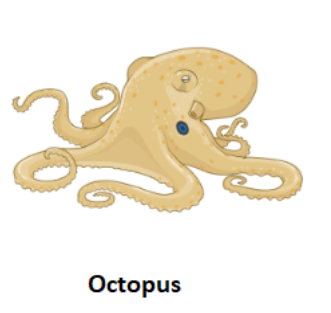
Which of the following class includes octopus?
A. Mollusca
B. Pelecypoda
C. Arthropoda
D. Cephalopoda
Answer
562.5k+ views
Hint: Octopus is a soft-bodied animal which has eight limbs. It belongs to the order Octopoda. Octopus animals are bilaterally symmetrical and have a beak and two eyes. Due to its soft body, it can squeeze itself to move through small gaps.
Complete answer: The scientific study which involves naming and defining and classifying biological organisms in groups depending on the shared characteristics is called taxonomy. The organisms are grouped into taxon and are given taxonomic rank to each taxon. Depending upon the rank the taxon is named as domain, kingdom, phylum, class, order, family, genus, and species. In botany instead of phylum, the division is used. The current system of taxonomy is found by the Swedish botanist Carl Linnaeus. The critical component of the taxonomic process is biological classification. A soft-bodied animal with eight limbs called octopus belongs to the phylum Mollusca and class of Cephalopoda of kingdom Animalia. The body of an octopus is bilaterally symmetrical with its head in the center of eight limbs. The limbs of an octopus are called appendages. As they swim, they trail their appendages behind them. The siphon is used for the process of locomotion and for respiration by expelling jets of water. The second-largest phylum of invertebrates is phylum Mollusca. Arthropoda is a phylum of invertebrates that show the presence of an exoskeleton, paired jointed appendages, and segmented body. Therefore, octopus belongs to the class of Cephalopoda.

So, option D is the correct option.
Note: Other animals that belong to class Cephalopoda are squids, cuttlefish, and nautilus. Cephalopods are extremely marine animals that are characterized by the presence of a prominent head, set of arms or tentacles, and bilateral symmetrical body. Cephalopods are commonly called ink fish by the fishermen.
Complete answer: The scientific study which involves naming and defining and classifying biological organisms in groups depending on the shared characteristics is called taxonomy. The organisms are grouped into taxon and are given taxonomic rank to each taxon. Depending upon the rank the taxon is named as domain, kingdom, phylum, class, order, family, genus, and species. In botany instead of phylum, the division is used. The current system of taxonomy is found by the Swedish botanist Carl Linnaeus. The critical component of the taxonomic process is biological classification. A soft-bodied animal with eight limbs called octopus belongs to the phylum Mollusca and class of Cephalopoda of kingdom Animalia. The body of an octopus is bilaterally symmetrical with its head in the center of eight limbs. The limbs of an octopus are called appendages. As they swim, they trail their appendages behind them. The siphon is used for the process of locomotion and for respiration by expelling jets of water. The second-largest phylum of invertebrates is phylum Mollusca. Arthropoda is a phylum of invertebrates that show the presence of an exoskeleton, paired jointed appendages, and segmented body. Therefore, octopus belongs to the class of Cephalopoda.

So, option D is the correct option.
Note: Other animals that belong to class Cephalopoda are squids, cuttlefish, and nautilus. Cephalopods are extremely marine animals that are characterized by the presence of a prominent head, set of arms or tentacles, and bilateral symmetrical body. Cephalopods are commonly called ink fish by the fishermen.
Recently Updated Pages
Why are manures considered better than fertilizers class 11 biology CBSE

Find the coordinates of the midpoint of the line segment class 11 maths CBSE

Distinguish between static friction limiting friction class 11 physics CBSE

The Chairman of the constituent Assembly was A Jawaharlal class 11 social science CBSE

The first National Commission on Labour NCL submitted class 11 social science CBSE

Number of all subshell of n + l 7 is A 4 B 5 C 6 D class 11 chemistry CBSE

Trending doubts
10 examples of friction in our daily life

One Metric ton is equal to kg A 10000 B 1000 C 100 class 11 physics CBSE

Difference Between Prokaryotic Cells and Eukaryotic Cells

1 Quintal is equal to a 110 kg b 10 kg c 100kg d 1000 class 11 physics CBSE

State the laws of reflection of light

Explain zero factorial class 11 maths CBSE




